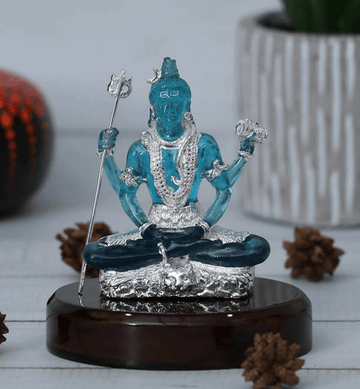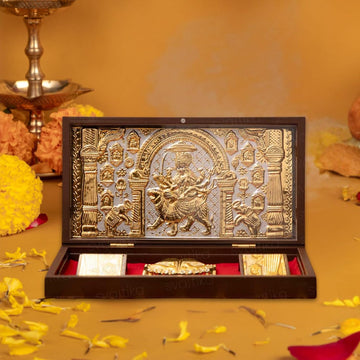Setting Up Your First Pooja Space? Here Are the Pooja Essentials
Create a sacred corner that connects your soul to divinity, rooted in tradition, tailored for your home.
Introduction: The Sacred Importance of a Pooja Space
When there is a space for pooja in a home, a sacred stillness descends that goes beyond the idols, incense, and configuration of how to place everything. It is a place where man interacts with the cosmos, a space where silence can speak, and where prayers are released. In the hustle and bustle of life as we know it every day, establishing a home altar setup brings with it more than simply ritual; it brings rhythm.
Many of us, especially those far from home, utilize a pooja room as our temple, a space that keeps us rooted, while simultaneously allowing our children to visualize where we come from. Whether you are married, moving into a new place, or just feeling called to establish a pooja space, creating an altar is one of the best journeys you can go on. This is your beginner's guide to pooja space, a gentle yet powerful entry into sacred living.
Choose the Right Location: Find a Peaceful Spot
According to Vastu Shastra, the north-east corner (Ishanya) is the ideal placement for a Hindu prayer room setup, as it is affiliated with divine energies and spiritual clarity. If that is not possible, the east or north positioning is also acceptable.
Choose a spot that is:
-
Quiet and undisturbed
-
Clean and clutter-free
-
Away from the bathroom or kitchen
-
Receives soft natural light, if possible
Modern homes often lack a dedicated pooja room, which is fine. A corner of your living room, an untouched shelf in your bedroom, or a little cubby punched out of the hallway can be your holy haven. These are all practical mandir setup tips for small homes.
Essential Pooja Items: Must-Haves for Every Altar
Creating your first pooja space can feel overwhelming, but it really comes down to a few pooja space essentials:
-
Murti or framed images of your chosen deities
-
Pooja thali essentials (detailed below)
-
Diyas or lamps for lighting
-
Incense holder and agarbatti
-
Kalash (sacred pot) with mango leaves and coconut
-
Bell (ghanti) for invocation
-
Chandan, kumkum, haldi, and akshat (unbroken rice)
-
Fresh flowers or garlands
-
Clean cloth or a pooja asan to sit upon
These must-have pooja items serve as the physical tools through which devotion flows. Each item carries symbolic weight from the diya that chases away ignorance to the bell that clears the air of distractions.
Selecting Deities and Murtis: Whom to Worship
Hinduism provides a very individualized connection to divinity. You might worship Ganesha for beginnings, Lakshmi for prosperity, Shiva for change, or Durga for empowerment. You might import your kuladevata (family god/goddess) or your Ishta Devata (personal story).
You can have multiple deities, but avoid overstuffing your altar. If possible, keep your attention during prayer undiluted.
Opt for brass, marble, or wood murtis, and ensure they are clean, upright, and respectfully placed. The house of Wemy’s handcrafted idols bring not just aesthetics but deep spiritual resonance into the home, perfect additions to your Pooja Essentials.
Set Up the Altar: Layout and Organization Tips
The altar should be at eye level or slightly above. Keep deities at the center, with diya and incense to the right, and water or offerings to the left. Use a raised wooden or marble chowki draped with a clean cloth.
Tips:
-
Keep regularly used items accessible.
-
Avoid storing clutter or unrelated items around the pooja setup.
-
Use trays to neatly organize your pooja items checklist.
A beautiful home altar setup is not about opulence; it’s about devotion, clarity, and intention.
Pooja Thali Essentials: What to Include
Your pooja thali is a microcosm of the universe, each item representing a different element of creation.
A traditional thali includes:
-
Diya (fire)
-
Kumkum and turmeric (earth)
-
Flowers (life/air)
-
Rice grains (nourishment)
-
Bell (sound/vibration)
-
Small Kalash (water)
-
Camphor or incense (air + ether)
You can enhance your setup with the House of Wemy’s elegant pooja thali essentials, made from brass and copper, designed to reflect timeless Indian traditions.
Lighting the Space: Diyas, Lamps, and Candles
Lighting the diya isn’t just symbolic, it’s transformative. The flicker of the flame represents the Atman (soul), dispelling darkness within and around.
Choose from:
-
Brass diyas: Long-lasting and traditional
-
Aroma candles: Blend devotion with ambiance
-
Akhanda deepams: For uninterrupted light during festivals
Place your diya in the southeast direction of your altar. Light it with pure ghee or sesame oil during evening prayers, facing east or north an essential part of any Hindu prayer room setup.
Sacred Sounds: Bells, Conch Shells, and Mantra Recordings
In Hinduism, sacred sound constitutes a direct pathway to divinity. The ringing of a bell signifies the invitation of divinity during pooja, while the blowing of the shankh (conch) emphasizes the cosmic creation sound Om.
If you are new to this, it is okay to use recorded mantras or chants. You can pick:
-
Vishnu Sahasranama
-
Gayatri Mantra
-
Shiva Tandava Stotram
-
Lalitha Sahasranamam
Over time, chanting even one line daily will make your space feel alive a vital tip in any beginners guide to pooja space.
Pooja Cloths and Decor: Dressing the Sacred Space
Just like we wear fresh clothes for pooja, so should our altar. Choose bright, clean clothes for the chowki and decorative backdrops, torans or bandhanwars for the mandir.
Simple puja room decoration ideas include:
-
Fresh flowers or artificial garlands
-
Brass bells or wall hangings
-
Rangoli patterns during festivals
-
Incense and camphor stands
The House of Wemy offers pooja cloths and décor accessories crafted to bring beauty and sanctity into your home, effortlessly blending tradition with elegance.
Keeping It Pure: Tips for Cleanliness and Energy Flow
Purity is the foundation of any pooja. A cluttered, dusty space attracts stagnation, not spirituality.
Cleanliness tips:
-
Wipe the space daily.
-
Replace flowers and water regularly.
-
Don’t place footwear nearby.
-
Use incense or loban to purify the air.
You can also place rock salt bowls nearby to absorb negativity or hang a nazar battu for protection, simple tricks that complete your pooja space essentials.
Daily Ritual Basics: Simple Pooja Practices for Beginners
You don’t need elaborate rituals to start. Even five minutes of mindful connection is enough.
Beginner’s pooja flow:
-
Wash hands and feet.
-
Light a diya and incense.
-
Ring the bell thrice.
-
Offer water, rice, and flowers.
-
Chant a simple mantra or recite shlokas.
-
Meditate or sit in silence for 1-2 minutes.
Start small. The divine is not impressed by complexity, but by consistency and love. This is the heart of how to set up pooja room practices in daily life.
Personal Touches: Making the Space Truly Yours
Your pooja space should reflect your journey. Add items that resonate with your spiritual path:
-
A photo of your guru or lineage
-
Books like the Bhagavad Gita or Ramayana
-
A notebook for daily prayers or reflections
-
Handmade items from your children
-
A diya gifted by your grandmother
The more personal the space feels, the stronger your connection will be.
Common Mistakes to Avoid When Setting Up Your First Pooja Space
As a beginner, steer clear of these common errors:
-
Placing idols facing each other or you directly
-
Using broken or chipped murtis
-
Overcrowding the altar
-
Leaving expired flowers or offerings overnight
-
Mixing unrelated items like electronics or bills in the same area
Let your altar remain sacred, simple, and serene, a peaceful reflection of your devotion and well-chosen pooja items checklist.
Ending Thoughts: Creating a Space That Nurtures Your Spirit
Setting up a pooja space is not just a religious act; it’s a return to the soul. In a world of endless noise, this small corner offers silence. In an era of screens, it offers presence. And in moments of chaos, it becomes your personal temple of calm.
Whether you light a diya before leaving for work, chant a shloka with your child before bedtime, or simply sit in silence with folded hands, your pooja space will hold you in ways nothing else can.
What will your sacred corner look like? What memories and meanings will it hold for you and your family?
Explore The House of Wemy’s collection of handcrafted pooja items, décor, and sacred gifts to bring your vision to life, steeped in tradition, made for today.










